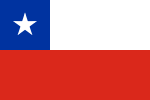The Región de Aisen del General Ibáñez del Campo is the third largest and most sparsely populated region in terms of area Chile. It is located in the south of the country.
Only part of the region is connected to the transport network, numerous places, especially on the many islands, are practically cut off from civilization.
| location | ||
places

- 1 Coyhaique
 , the capital, 50,000 inhabitants, in one of the few fertile valleys
, the capital, 50,000 inhabitants, in one of the few fertile valleys - 2 Puerto Aysén, former port city with 20,000 inhabitants, west of Coyhaique. Starting point for trips to Campo de Hielo Norte (Laguna San Rafael). The actual port is located 15 km away Puerto Chacabuco.
- 3 Chile Chico
 , on the border with Argentina on Lago General Carrera, with a mild and relatively dry microclimate, 4,000 inhabitants.
, on the border with Argentina on Lago General Carrera, with a mild and relatively dry microclimate, 4,000 inhabitants. - 4 Cochrane
 , 3,000 inhabitants, southernmost major town
, 3,000 inhabitants, southernmost major town - 5 Puerto Cisnes, 3,000 inhabitants, important port city
- 6 Melinka, 1,500 inhabitants, on a remote island in the northwest, known for the blue whales in the area, but difficult to get to and practically without any tourist infrastructure
- 7 Caleta tortel
 , small pile dwelling settlement by the fjord in the extreme south, increasingly a tourist destination
, small pile dwelling settlement by the fjord in the extreme south, increasingly a tourist destination - 8 Villa O'Higgins
 , 500 inhabitants, end point of the Panamericana. Connected to the rest of the region only since 1999, located on the border with Argentina.
, 500 inhabitants, end point of the Panamericana. Connected to the rest of the region only since 1999, located on the border with Argentina. - 9 Villa Cerro Castillo, Village near Cerro Castillo National Reserve, many hiking opportunities
- 10 Puyuhuapi, Tourist place on Queulat National Park, known for its hanging glacier
National parks and reserves

Large areas of the province (48%) are under nature protection, especially in the remote areas of the coastal cordillera and the inland ice fields.
National parks
- 1 Laguna San Rafael National Park
 , with 1.7 million hectares the largest and most famous park in the region, west of Cochrane and Puerto Río Tranquilo
, with 1.7 million hectares the largest and most famous park in the region, west of Cochrane and Puerto Río Tranquilo - 2 Queulat National Park
 , in the very north of the province west of Puyuhuapi, 154,039 hectares
, in the very north of the province west of Puyuhuapi, 154,039 hectares - 3 Isla Guamblin National Park, offshore island in the Pacific that is completely protected, 10,625 hectares
- 4 Bernardo O'Higgins National Park
 , the largest national park in Chile is for the most part in the southern neighboring province Región de Magallanes y de la Antártica Chilena, but there are still an impressive 921,000 hectares in the Aisén region.
, the largest national park in Chile is for the most part in the southern neighboring province Región de Magallanes y de la Antártica Chilena, but there are still an impressive 921,000 hectares in the Aisén region.
National reserves
- National Reserve Lago Rosselot, 12,725 hectares
- Las Guaitecas National Reserve, Coastal cordillera north of Laguna San Rafael National Park, 1,097,975 hectares
- Lago Carlota National Reserve, 18,060 hectares
- Lago los Torres National Reserve, west of the Carretera Austral at Villa Amengual, 16,516 hectares
- Mañihuales National Reserve, 3,586 hectares
- Trapananda National Reserve, on the border to Argentina, 2,305 hectares
- Río Simpson National Reserve, West of Coyhaique, 41,369 hectares
- Coihaique National Reserve, in the north of Coyhaique, 2,105 hectares
- Cerro Castillo National Reserve, at Villa Cerro Castillo, 138,164 hectares
- Lake Jeinimeni National Reserve, south of the Lago General Carrera at Chile Chico, 161,100 hectares
- Tamango National Reserve, at Cochrane on Lake Cochrane, 6,943 hectares
- Katalalixar National Reserve, Coastal region between the national parks Laguna San Rafael and Bernardo O'Higgins,
674,500 hectares
Natural monuments
- Cinco Hermanas, Island in the Aisén Fjord Puerto Aysén, 228 hectares
- Dos Lagunas, east of Coyhaique, 180 hectares
background
The Aisén region is probably the most remote and wildest area in Chile. For a long time, most places could only be reached via Argentina or by air, until the ecologically controversial one in the 1970s Carretera Austral, the continuation of the Panamericana network. So far it has been a gravel road, which is still an adventure to cross, but in the next few years it will be tarred against the resistance of environmental organizations.
The region is characterized by evergreen, subpolar rainforests, fjords, numerous islands, which are often difficult to reach, and the glacier landscapes of Campo de Hielo Norte and Campo de Hielo Sur. There is only a tourist infrastructure in individual places. The distances in between are great.
language
getting there
The most convenient is next to the air (Coyhaique and Chile Chico) the arrival via Argentina. Another option is to take the ferry from Puerto Montt or that Chiloe Archipelago.
mobility
Tourist Attractions
- 5 Laguna San Rafael
 (Parque nacional Laguna San Rafael). Glacier lake of breathtaking beauty. Less known than the Argentine Lake Argentino with the Los Glaciares National Park, but almost on a par in terms of landscape.
(Parque nacional Laguna San Rafael). Glacier lake of breathtaking beauty. Less known than the Argentine Lake Argentino with the Los Glaciares National Park, but almost on a par in terms of landscape.
activities
kitchen
nightlife
security
climate
The climate is one of the rainiest on earth, especially directly on the coast, measuring over 5000 mm per year. In summer the temperatures are cool (around 15 ° C) and in winter they are relatively mild (around 5 ° C).












.jpg/350px-Glacier_in_Parque_Nacional_Queulat_(3184588913).jpg)

